Estrildidae
Estrildidae, or estrildid finches, is a family of small passerine birds of the Old World tropics and Australasia. They comprise species commonly known as munias, mannikins, firefinches, parrotfinches and waxbills.[1] Sometimes they are treated as a subfamily, Estrildinae, within the family Passeridae; Passeridae narrowly defined comprises the Old World sparrows.[2] Despite the word "finch" being included in the common names of many of the species, they are not closely related to birds with this name in other families, such as the Fringillidae, Emberizidae or Passerellidae.
| Estrildidae | |
|---|---|
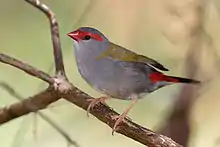 | |
| Red-browed finch, Neochmia temporalis | |
| Scientific classification | |
| Kingdom: | Animalia |
| Phylum: | Chordata |
| Class: | Aves |
| Order: | Passeriformes |
| Superfamily: | Passeroidea |
| Family: | Estrildidae Illiger, 1811 |
| Genera | |
They are gregarious and often colonial seed eaters with short, thick, but pointed bills. They are all similar in structure and habits, but vary widely in plumage colours and patterns.
All estrildids build large, domed nests and lay five to ten white eggs. Many species build roost nests. Some of the firefinches and pytilias are hosts to the brood-parasitic indigobirds and whydahs, respectively.
Most are sensitive to cold and require warm, usually tropical, habitats, although a few, such as the eastern alpine mannikin, mountain firetail, red-browed finch, and the genus Stagonopleura, have adapted to the cooler climates of southern Australia and the highlands of New Guinea.
The smallest species of the family is the Shelley's oliveback (Nesocharis shelleyi) at a mere 8.3 centimetres (3.3 in), although the lightest species is the black-rumped waxbill (Estrilda troglodytes) at 6 g (0.21 oz). The largest species is the Java sparrow (Padda oryzivora) at 17 cm (6.7 in) and 25 g (0.88 oz).[3]
Evolution

The phylogeography and possible origin of estrildid species have been studied. The following scheme may be useful to represent a hypothetical origin in India in the last and strongest Himalayas uplift (16.5 million years ago), when the monsoon rains regime was established in India (see figure). The conclusions from this study[4][5] are:
- The estrildids form a monophyletic group that includes several polytomies and comprises African, Asian and Australian birds.
- They may have started evolving by the Middle Miocene epoch (about 16.5 million years ago)
- This proposed timing is coincidental with the Fringillinae radiation starting time and also with the main Himalayan and Tibetan Plateau uplift, triggered by the Indian tectonic plate collision; this established present day southern Asia monsoon regime and other drastic climatic changes, like drier weather in the Tibetan Plateau and Chinese deserts.
- The most ancient evolutionary group comprises African (African silverbill), Asian (Indian silverbill) and Australian (diamond firetail) species; this suggests that the whole estrildid radiation might have originated around India.[4][6][7]
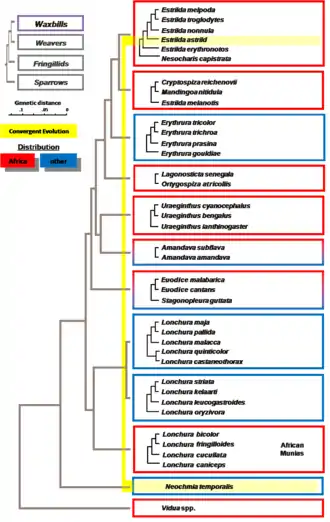
- The African group Nesocharis is grouped with the African genus Estrilda.
- The Gouldian finch (Erythrura or Chloebia gouldiae) is included within genus Erythrura.
- The Java sparrow (Padda or Lonchura oryzivora) is a highly modified species from genus Lonchura: bigger than the rest of Lonchura species, with a conspicuous and quite different head pattern. It is endemic to Java, Bali, and the Bawean Islands, although escapees from captivity can be seen today in other neighboring islands.
- African munias (Spermestes) belong to a genus different from Australian and Asian munias.
- The Australian red-browed firetail (Neochmia temporalis), very similar to African common waxbill (Estrilda astrild), is not closely related to it. Their similarities (bill, red brow, etc.) are due to convergent evolution, since their environmental pressures (weather, habitat, feeding) are similar.[4][7]
Genera list
| Image | Genus | Living species |
|---|---|---|
 | Parmoptila Cassin, 1859 (Antpecker) |
|
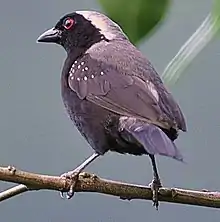 | Nigrita Strickland, 1843 (negrofinches) |
|
 | Nesocharis Alexander, 1903 (Olivebacks) |
|
.jpg.webp) | Delacourella Wolters, 1949 |
|
.jpg.webp) | Pytilia Swainson, 1837 |
|
_(male).jpg.webp) | Cryptospiza Salvadori, 1884 (Crimsonwings) |
|
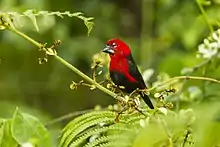 | Pyrenestes Swainson, 1837 (Seedcracker) |
|
.jpg.webp) | Spermophaga Swainson, 1837 (Bluebill) |
|
 | Mandingoa Hartert, 1919 |
|
.jpg.webp) | Clytospiza Shelley, 1896 |
|
.jpg.webp) | Hypargos L. Reichenbach, 1862 |
|
.jpg.webp) | Euschistospiza Wolters, 1943 |
|
_male.jpg.webp) | Lagonosticta Cabanis, 1851 (firefinches) |
|
_male.jpg.webp) | Uraeginthus Cabanis, 1851 (cordon-bleus) |
|
.jpg.webp) | Granatina Sharpe, 1890 |
|
 | Coccopygia Reichenbach, 1862 |
|
.jpg.webp) | Brunhilda Reichenbach, 1862 (waxbills) |
|
.jpg.webp) | Glaucestrilda Roberts, 1922 (waxbills) |
|
.jpg.webp) | Estrilda Swainson, 1827 (waxbills) |
|
.jpg.webp) | Amandava Blyth, 1836 (avadavats) |
|
_male.jpg.webp) | Ortygospiza (Vieillot, 1817) |
|
| Paludipasser Neave, 1909 |
| |
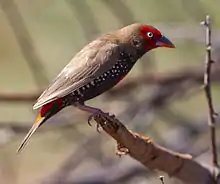 | Emblema Gould, 1842 |
|
 | Stagonopleura L. Reichenbach, 1850 (firetails) |
|
 | Oreostruthus De Vis, 1898 |
|
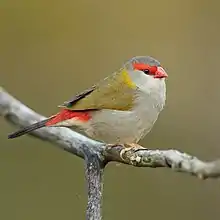 | Neochmia G.R. Gray, 1849 |
|
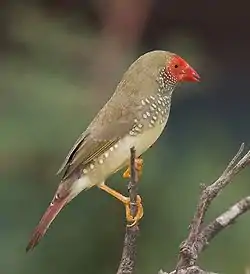 | Bathilda Reichenbach, 1862 |
|
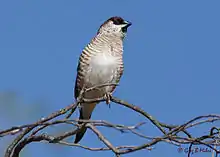 | Aidemosyne Reichenbach, 1862 |
|
.jpg.webp) | Taeniopygia Reichenbach, 1862 |
|
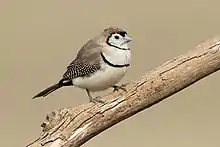 | Stizoptera Oberholser, 1899 |
|
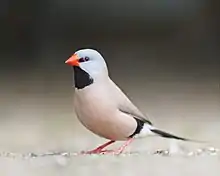 | Poephila Gould, 1842 |
|
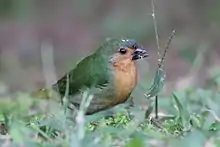 | Erythrura Swainson, 1837 (Parrotfinches) |
|
_Wildlife_Habitat_Port_Douglas%252C_Queensland_(32149977195).jpg.webp) | Chloebia Reichenbach, 1862 |
|
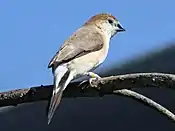 | Euodice L. Reichenbach, 1862 |
|
.jpg.webp) | Lepidopygia Reichenbach, 1862 |
|
 | Spermestes Swainson, 1837 (munias, mannikins and silverbills) |
|
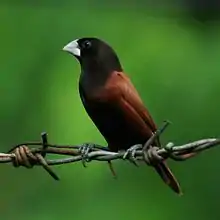 | Lonchura Sykes, 1832 (munias, mannikins and silverbills) |
|
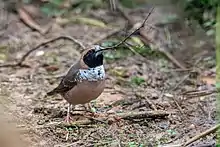 | Heteromunia Mathews, 1913 |
|
_edit.jpg.webp) | Amadina Swainson, 1827 (Cut-throats) |
|
References
- Gill, Frank; Donsker, David. "Waxbills, parrotfinches, munias, whydahs, Olive Warbler, accentors, pipits « IOC World Bird List". www.worldbirdnames.org. IOC World Bird List (v8.2).
- Christidis, L.; Boles, W.E. (2008). Systematics and Taxonomy of Australian Birds. Canberra: CSIRO Publishing. p. 177. ISBN 978-0-643-06511-6.
- "Estrildid FINCHes".
- Arnaiz-Villena A, Ruiz-del-Valle V, Gomez-Prieto P, Reguera R, Parga-Lozano C, Serrano-Vela JI (2009). "Estrildinae Finches (Aves, Passeriformes) from Africa, South Asia and Australia: a Molecular Phylogeographic Study" (PDF). The Open Ornithology Journal. 2: 29–36. doi:10.2174/1874453200902010029.
- Arnaiz-Villena, Antonio; Gomez-Prieto, Pablo; Ruiz-Del-Valle, Valentin (2009). Phylogeography of Finches and Sparrows. Nova Science Publishers. ISBN 978-1-60741-844-3.
- Sibley, C.G.; Monroe, B.L. (1990). Distribution and Taxonomy of Birds of the World. Yale University Press.
- Arnaiz-Villena, A.; Gomez-Prieto, P.; Serna-Ayala, J.M.; Ruiz-del-Valle, V. (2009). El origen de los Estríldidos [The origin of the Estríldidos] (PDF) (Report) (in Spanish).
External links
- Zipcode Zoo: Estrildidae
- Internet Bird Collection.com: Estrildidae videos, photos and sounds
- Waxbill Finch Society — specialist waxbill bird society based in the UK.
| Wikimedia Commons has media related to Estrildidae. |